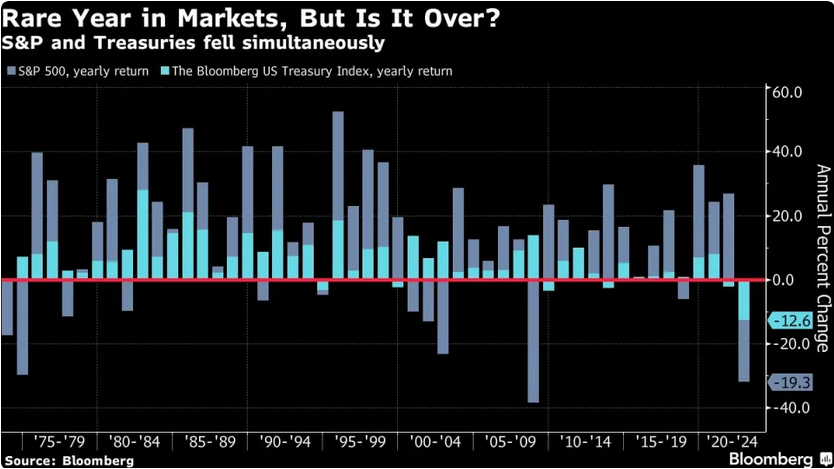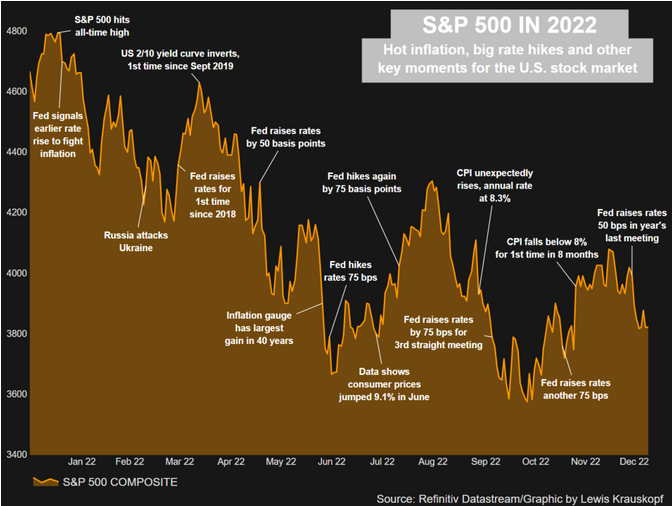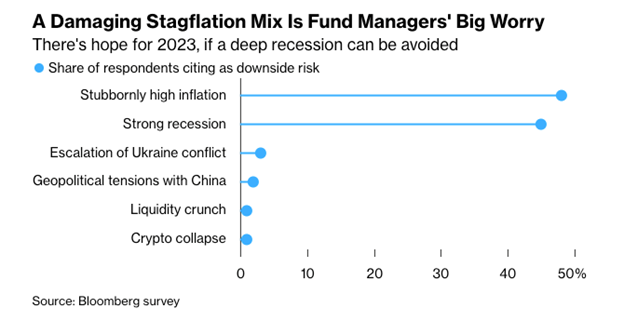The Year of the Fed’s Inflation Showdown
Quick Take: The Federal Reserve capped off a year of aggressive rate hikes by raising its benchmark interest rate to the highest level in 15 years.[1]
As central banks raced to fight inflation by hiking interest rates, 2022 ended with a dismal record – the worst year in more than a decade for global equities and bonds.[2]

Source: https://www.yahoo.com/now/asia-stocks-rise-p-500-233248167.html
The benchmark S&P 500 equity index shed 19.4% for the year, losing roughly $8 trillion in market cap.[3] Tech-heavy Nasdaq saw heavy losses, losing a third of its value.[4] Bonds were also not spared, with Treasuries and corporate bonds logging miserable returns as the Bloomberg Aggregate US Bond Index had its worst year since its inception in 1977.[5] Treasury yields rose (prices lower) on the final trading day, with the 10-year US Government Bond rate touching a seven-week high.[6]

Source: https://www.reuters.com/legal/government/inflation-recession-earnings-among-factors-drive-us-stocks-2023-2022-12-30/
This year’s market moves were largely driven by a hawkish Federal Reserve (Fed) tightening monetary policy in response to the unexpected spike in inflation. Market expectations remain somewhat hopeful, as a possible peak in interest rates appear on the horizon, possibly in March.[7] Markets have also priced in expectations that the Fed may start cutting rates by the end of 2023.[8] This view is relatively optimistic, and before that happens, we still need to reach the end of this rate hike cycle.
The Fed’s Unwavering Commitment
The Fed capped off a year of aggressive rate hikes by raising its benchmark interest rate to a target range of 4.25%-4.5%, the highest level in 15 years.[9] The committee also raised its median estimate of its favored core inflation measure to 4.8%, up 0.3% from the September projections.[10]
Despite a challenging year in financial markets, the Fed’s actions suggest they are committed to keeping inflation under control. Their messaging on interest rates is essentially “higher for longer.”
To continue fighting inflation, Fed officials forecast that they could raise rates as high as 5.1%, which is more than the 4.6% projected in September.[11] Note that this is the median level projected by the Fed. In addition, officials indicated they expect to keep rates higher throughout the year, with no reductions until 2024. The Fed expects rates only to fall to 4.1% in 2024, which is also higher than previous indications.[12]
“The historical record cautions strongly against prematurely loosening policy. We will stay the course, until the job is done,” Fed Chairman Jerome Powell reiterated.[13]
Covid – Again
The Fed has had such a tough job fighting inflation largely because of the supply and labor disruptions from the pandemic. Although it’s been three years, Covid is still making headlines. The pandemic is now spreading in China after the country definitively started easing its Covid zero-tolerance policy in December following widespread protests.[14]
Covid’s rapid spread is in danger of causing additional supply chain disruptions. China’s government has stopped releasing official case counts, but it’s estimated that up to 248 million people (18% of the population) may have contracted the virus in the first 20 days of December.[15] The US is requiring travelers from China to show negative Covid-19 test results before flying.[16]
As a result of the outbreak, the world’s second-largest economy will likely experience disruptions in the coming months, though that can also increase the possibility of a faster and a stronger rebound in growth later in the year.[17]
Themes for the New Year
In the rest of the world, central banks have notably tried to trigger demand slowdowns in order to crush inflation. However, tighter financial conditions still need time to filter through the economy. As we look ahead to the new year, several themes stand out.
Economic Slowdown
Most predictions for a recession in 2023 expect that it will be shallow and mild.[18] Recessions tend to hit stocks, though declines are often followed by a strong rebound.[19] Stubbornly high inflation or a deeper recession are the top concerns for fund managers surveyed by Bloomberg.

Source: https://www.bloomberg.com/news/articles/2022-12-09/world-s-money-managers-see-double-digit-stock-gains-in-2023
Earnings
According to Morgan Stanley Chief US Equity Strategist Mike Wilson, the final chapter of the bear market is all about the path of earnings estimates, which could be optimistic.[20] Analyst estimates still project S&P 500 earnings to rise 4.4% in 2023, although earnings tend to fall during recessions.[21] The market will be paying close attention to corporate earnings for any signs of weakness.
Employment
The job market remains a bright spot, as the Bureau of Labor Statistics reported another month of higher-than-expected hiring in November. Wage growth increased 5.1% year-over-year, also higher than estimates.[22] Without a slowdown in the job market, an immediate recession is relatively unlikely. Job market resilience keeps the Fed on its monetary policy tightening path, probably at least through the beginning of 2023. The next Federal Open Market Committee meeting will be in February.[23]
What’s Next
2022 was full of surprises ranging from Fed hawkishness to the horrific ongoing war between Russia and Ukraine. Under this backdrop, stocks and bonds have illustrated that they can move in tandem, which makes tactical and granular investment approaches more appealing, according to Blackrock.[24]
It’s important to take a big picture view without getting caught up trying to predict exactly what comes next. While uncertainty remains in markets, bear markets also create opportunities. We appreciate your ongoing confidence and support through ups and downs. We treasure the opportunity to work together with you over the long term to hopefully turn your goals and aspirations into reality. Please reach out if you would like to start the year out with a call, zoom or in-person meeting to catch-up, refocus, and work together to collectively determine the optimal path forward.
Wishing you and your family a happy, healthy, and prosperous 2023!
Your Friends at JSF
The information expressed herein are those of JSF Financial, LLC, it does not necessarily reflect the views of NewEdge Securities, Inc. Neither JSF Financial LLC nor NewEdge Securities, Inc. gives tax or legal advice. All opinions are subject to change without notice. Neither the information provided, nor any opinion expressed constitutes a solicitation or recommendation for the purchase, sale or holding of any security. Investing involves risk, including possible loss of principal. Indexes are unmanaged and cannot be invested in directly.
Historical data shown represents past performance and does not guarantee comparable future results. The information and statistical data contained herein were obtained from sources believed to be reliable but in no way are guaranteed by JSF Financial, LLC or NewEdge Securities, Inc. as to accuracy or completeness. The information provided is not intended to be a complete analysis of every material fact respecting any strategy. The examples presented do not take into consideration commissions, tax implications, or other transactions costs, which may significantly affect the economic consequences of a given strategy. Diversification does not ensure a profit or guarantee against loss. Carefully consider the investment objectives, risks, charges and expenses of the trades referenced in this material before investing.
Asset Allocation and Diversification do not guarantee a profit or protect against a loss.
The Bloomberg Barclays U.S. Aggregate Bond Index measures the investment-grade U.S. dollar-denominated, fixed-rate taxable bond market and includes Treasury securities, government-related and corporate securities, mortgage-backed securities, asset-backed securities and commercial mortgage-backed securities.
The S&P 500 Index is an unmanaged, market value-weighted index of 500 stocks generally representative of the broad stock market.
The Nasdaq Composite is a market-capitalization-weighted index consisting of all Nasdaq Stock Exchange listed stocks that are not derivatives, preferred shares, funds, exchange-traded funds or debenture securities.
Treasury Bond- is a U.S. government debt security with a fixed interest rate and maturity between two and 10 years.
Gross domestic product (GDP) is a monetary measure of the market value of all the final goods and services produced in a specific time period. GDP is the most commonly used measure of economic activity.
By clicking on these links, you will leave our server, as they are located on another server. We have not independently verified the information available through this link. The link is provided to you as a matter of interest. Please click on the links below to leave and proceed to the selected site.
[1] https://www.cnbc.com/2022/12/14/fed-rate-decision-december-2022.html
[2] https://www.yahoo.com/now/asia-stocks-rise-p-500-233248167.html
[3] https://www.reuters.com/markets/us/futures-slip-last-trading-day-torrid-year-2022-12-30/
[4] https://www.yahoo.com/now/asia-stocks-rise-p-500-233248167.html
[5] https://www.cnn.com/2022/12/30/investing/dow-stock-market-2022
[6] https://www.yahoo.com/now/asia-stocks-rise-p-500-233248167.html
[7] https://gulfnews.com/business/markets/after-18-trillion-rout-global-stocks-face-more-hurdles-in-2023-1.92943083
[8] https://gulfnews.com/business/markets/after-18-trillion-rout-global-stocks-face-more-hurdles-in-2023-1.92943083
[9] https://www.cnbc.com/2022/12/14/fed-rate-decision-december-2022.html
[10] https://www.cnbc.com/2022/12/14/the-fed-projects-raising-rates-as-high-as-5point1percent-before-ending-inflation-battle.html
[11] https://www.cnbc.com/2022/12/14/the-fed-projects-raising-rates-as-high-as-5point1percent-before-ending-inflation-battle.html
[12] https://www.cnbc.com/2022/12/14/the-fed-projects-raising-rates-as-high-as-5point1percent-before-ending-inflation-battle.html
[13] https://www.cnbc.com/2022/12/14/live-updates-fed-rate-hike-december.html
[14] https://www.nytimes.com/2022/12/07/world/asia/china-zero-covid-protests.html
[15] https://www.cnn.com/2022/12/23/china/china-covid-infections-250-million-intl-hnk/index.html
[16] https://www.cnn.com/2022/12/28/politics/us-covid-measures-travelers-china/index.html
[17] https://economictimes.indiatimes.com/small-biz/trade/exports/insights/charting-the-global-economy-chinas-slump-deepens-into-year-end/articleshow/96657949.cms
[18] https://finance.yahoo.com/news/labor-market-still-really-strong-150809064.html
[19] https://www.reuters.com/legal/government/inflation-recession-earnings-among-factors-drive-us-stocks-2023-2022-12-30/
[20] https://gulfnews.com/business/markets/after-18-trillion-rout-global-stocks-face-more-hurdles-in-2023-1.92943083
[21] https://www.reuters.com/legal/government/inflation-recession-earnings-among-factors-drive-us-stocks-2023-2022-12-30/
[22] https://finance.yahoo.com/news/labor-market-still-really-strong-150809064.html
[23] https://www.federalreserve.gov/newsevents/calendar.htm
[24] https://www.blackrock.com/corporate/literature/whitepaper/bii-global-outlook-2023.pdf
